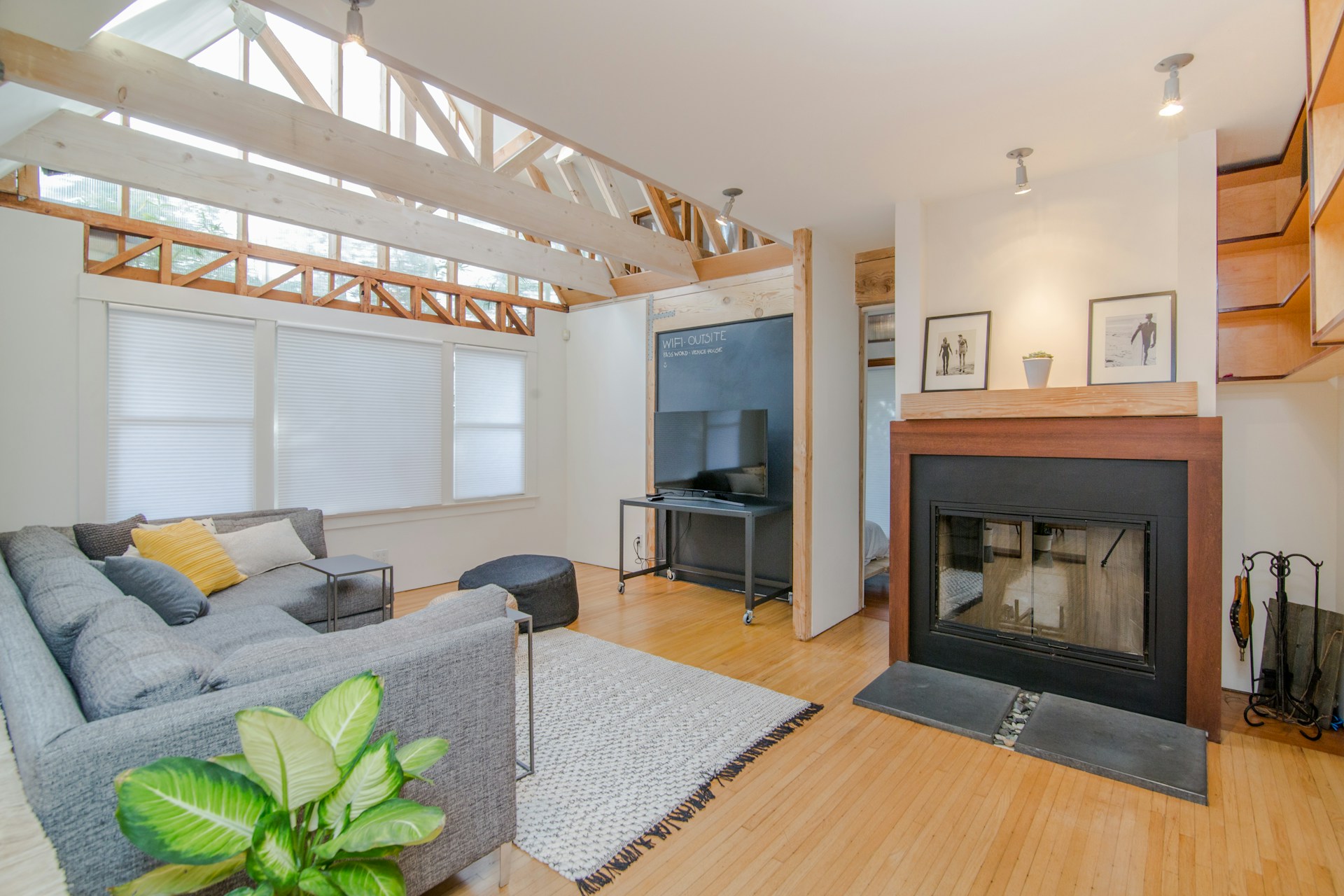Digital Nomads in Madrid: Work and Explore
Live as a digital nomad in Madrid: mix productivity with the charm of a city full of history, art and rich cuisine.
Being a digital nomad in Madrid is an irresistible magnet for those looking to balance work and pleasure. A report by Statista in 2023, indicates that this city ranked sixth in the ranking of cities preferred by expatriates.
Imagine enjoying a temperate climate while working and immersing yourself in a cultural offer that ranges from world-renowned museums to lively local festivals, accompanied by cuisine that delights every palate.
In this guide, we invite you to discover the secrets of life in the Spanish capital. We’ll give you the tools you need to establish yourself and flourish as a digital nomad in this city.
Why choose Madrid to live as a digital nomad?
Choosing Madrid as your base as a digital nomad offers multiple advantages:
Connectivity:
Adolfo Suárez Madrid-Barajas Airport connects the city with the rest of the world, facilitating international travel. In addition, the high-speed train network (AVE) allows fast travel to other Spanish cities such as Barcelona, Seville and Valencia.
Culture and leisure
Madrid is a cultural hotbed. From world-renowned museums such as the Prado Museum and the Reina Sofía Museum to theatres, art galleries and an extraordinary music scene, there is always something to do.
You can also enjoy its varied gastronomy, such as traditional tapas and more exotic flavours.
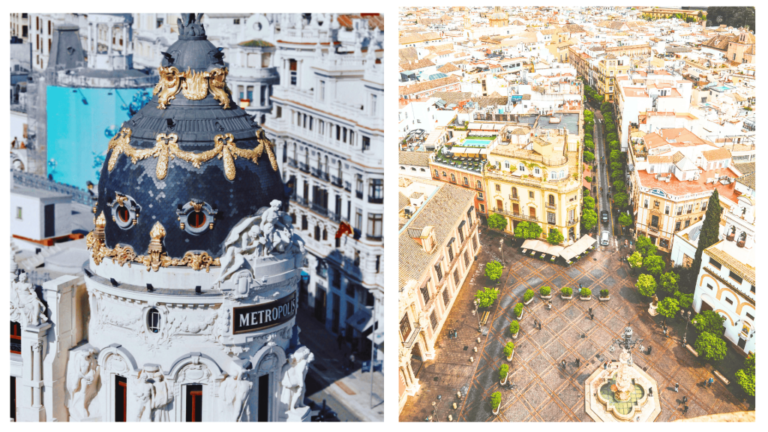
Community
The digital nomad community in Madrid is booming. Co-working spaces and networking events facilitate the creation of professional connections and friendships.
Cost of living
Although Madrid is a European capital, its cost of living is more affordable compared to cities like London or Paris. This allows digital nomads to enjoy a high quality of life without spending too much.
Is there a digital nomad visa for Madrid?
From 2023, Spain offers a specific visa for digital nomads that allows remote workers to live and work in the country. This visa is part of the Spanish government’s efforts to attract international talent.
| Features | Details |
| Duration | Up to one year, renewable |
| Income requirements | Minimum income of $2,000 per month |
| Nationality | Applies to non-EU citizens |
| Remote working | It must be with non-Spanish companies |
| Residence requirement | Proof of accommodation in Spain |
We invite you to explore our full article to get more details about the visa for digital nomads in Spain.
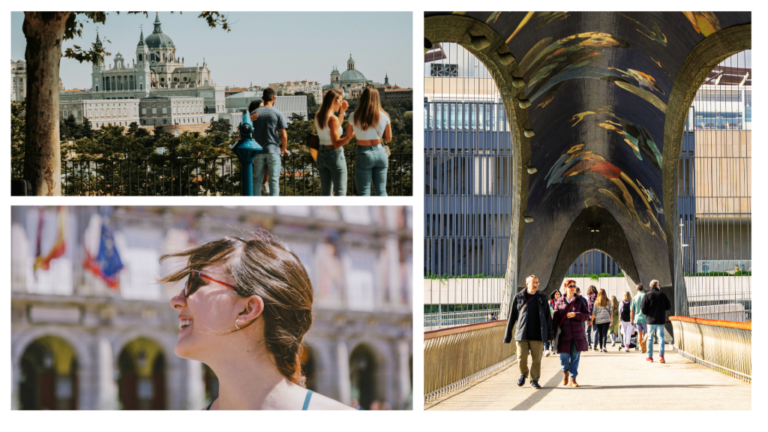
Where to live and work as a digital nomad in Madrid?
Madrid has a fascinating variety of neighbourhoods that are perfect for digital nomads. Each offers a unique atmosphere, with inspiring workspaces, cosy cafés and an active social life. Here are some of the most outstanding neighbourhoods you’ll love.
Malasaña
Malasaña is a bohemian neighbourhood, known for its alternative atmosphere that attracts artists and dreamers.
With a pleasant, temperate climate, it’s perfect for enjoying its outdoor terraces while you work. This neighbourhood is full of cafés, bars and art galleries, creating an inspiring environment for digital nomads.
Here you’ll find numerous co-working spaces, such as the popular Café de la Luz, where you can enjoy a delicious coffee while you immerse yourself in your projects.
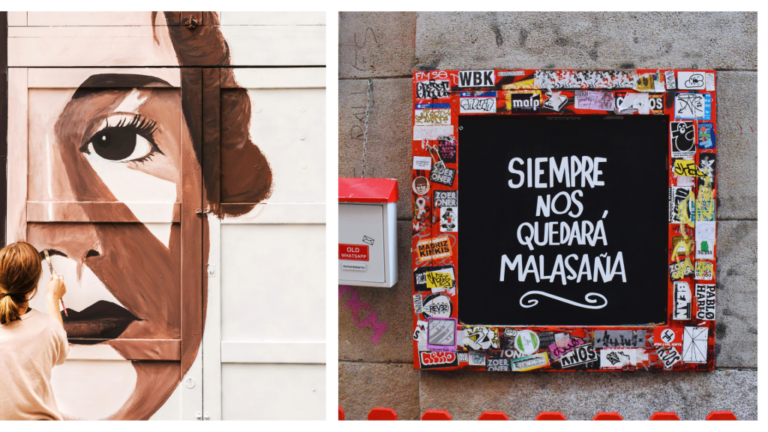
Chamartín
If you prefer a cooler climate in winter, Chamartín is an excellent option. This trendy business district is home to many technology companies and business centres, making it an ideal location for those seeking professional networking opportunities.
With excellent transport links, you can easily get around the city. In addition, the infrastructure in Chamartín facilitates access to offices and collaborative workspaces, which is perfect for keeping you productive.
La Latina
La Latina offers a traditional and authentic atmosphere, famous for its narrow streets and vibrant tapas life. With a warm, sunny climate in summer and mild winters, it’s an ideal place to enjoy local life.
Here you can visit the Cebada Market where you can enjoy fresh products and typical dishes. This neighbourhood is perfect for those looking for a rich cultural experience and a welcoming atmosphere, ideal for relaxing after a day’s work.
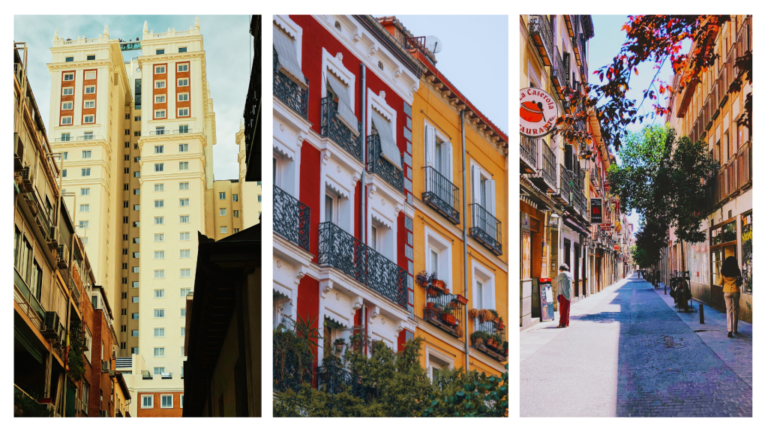
Retiro
If you’re looking for a quieter and more familiar environment, the Retiro neighbourhood has to be your choice. With a mild climate and green areas, this neighbourhood is close to the famous Retiro Park, an ideal place to relax and exercise.
Here you can enjoy bike rides, picnics and meditation spaces, allowing you to balance your work life with moments of well-being. Retiro is a haven for those who value peace and nature in their daily lives.
Accommodation options
There is a wide range of accommodation options in Madrid to suit different budgets and lifestyles:
1. Co-living spaces
Urban Campus Malasaña
- Private rooms with private or shared bathroom.
- Shared workspaces and welcoming common areas.
- Regular activities and events to foster community.
- Services such as cleanliness, high-speed internet and lounge areas.
- Estimated prices: Rates range from $750 to $1,300 per month, depending on the type of room and length of stay.
COLIVE – Coliving Madrid
- Fully furnished private rooms with services included.
- Common spaces designed for collaboration and work.
- Community activities and monthly workshops.
- Services such as weekly cleaning, internet and utilities included.
- Estimated prices: Rates are typically between $700 and $1,200 per month, depending on room size and location.
2. Hotels
There are many options, from boutique hotels in the centre that can cost between $80 and $200 a night, to cheaper options such as hostels that offer shared beds from $30 a night.
- Hotel Regina: A rather swanky downtown hotel with modern and comfortable rooms, restaurant, bar and easy access to public transport.
Approximate price: $120-200 per night
- Generator Madrid: A modern hostel that combines style and comfort. It offers both private and shared rooms, plus a rooftop terrace and a lively bar.
Approximate price: Shared beds from $30 and private rooms from $80 per night.

3. Home exchange
Platforms such as HomeExchange allow digital nomads to exchange their home for another in Madrid, which can result in significant savings.
Find the perfect place for your next life in Madrid. Visit our guide to accommodation for digital nomads in Madrid and find out more alternatives.
Co-working spaces
Co-working spaces in Madrid are perfect for digital nomads looking for an inspiring work environment:
- Impact Hub: Specialising in social entrepreneurs, from $250, with events and networking.
- WeWork: Extensive global network, with prices starting at $400, offering additional services such as meeting rooms and community activities.
Internet connection
Internet speed in Madrid is excellent, with an average of 50 Mbps in most areas, allowing you to work efficiently. Some public spaces that offer good connectivity include:
- Libraries: The National Library and several municipal libraries, which are quiet and suitable for study and work.
- Cafés: Café de Oriente y Toma Café are popular with digital nomads for their relaxed atmosphere and good connections.

To guarantee a reliable connection during your stay in Madrid, holafly’s unlimited data eSIM is the best option. Get connected easily and enjoy a seamless experience in this city.
Taxes to be aware of as a digital nomad in Madrid
Digital nomads need to be aware of their tax obligations in Madrid. Taxes are determined according to your tax residence and the double taxation treaties that Spain has with several countries, such as:
- United States
- Argentina
- Mexico
- Colombia
Digital nomads who reside more than 183 days in Spain are considered tax residents and must declare their income.
Important: If you are a frequent traveler and want to stay connected without worrying about expensive roaming or looking for a new SIM at every destination, Holafly’s subscription plans are for you. With a single eSIM, enjoy internet in more than 170 countries for a fixed price and no surprises on your bill. Travel without limits and connect easily and securely! 🚀🌍

Health insurance and quality of health service in Madrid
Madrid has a highly rated public health system. Medical care is of high quality and there are hospitals and clinics such as:
- Hospital Universitario La Paz: Renowned for its paediatric and emergency care.
- Clínica Santa Elena: Offers private health services with personalised care.
As a digital nomad in Madrid, we recommend that you take out health insurance that adapts to your needs, such as:
- SafetyWing: From $40 per month, ideal for digital nomads with international coverage.
- World Nomads: From $50 per month, offering protection for travel and adventure activities.
Basic expenses of a digital nomad in Madrid
Transport and mobility in Madrid
Madrid has an efficient public transport system:
- Metro: With a basic fare of $1.50 per trip and a monthly pass costing $54, it’s one of the fastest and cheapest ways to get around the city.
- Buses: Fares are similar to the metro, with an extensive network that complements the metro service.
- Taxis: Starting fares are almost four dollars, and it’s advisable to use apps such as Cabify or Uber for a better experience.
Digital nomads can use their valid foreign driver’s licence for up to 90 days, but it’s recommended to obtain an international permit if you plan to stay longer, as it’s valid for up to one year.
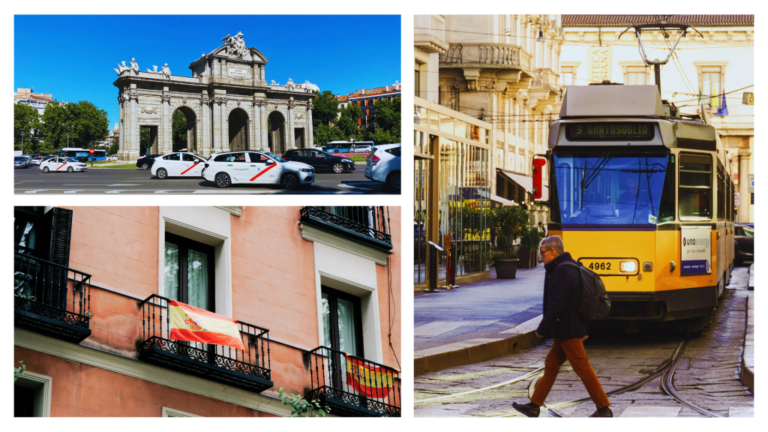
Managing your finances as a digital nomad in Madrid
The most recommended banks for foreigners are:
- BBVA: Offers accounts for non-residents and online banking options.
- Santander: With a strong international presence, it facilitates financial management.
There are also digital banking options such as N26 and Revolut which allow you to open accounts from abroad without needing a permanent address in Spain.
ATM withdrawal fees vary between two and five dollars per transaction, so it’s advisable to shop around to minimise costs.
Food costs in Madrid
The most common supermarkets are Mercadona and Carrefour where you can do your weekly shopping. A monthly food budget is between $200 and $300, depending on your consumption habits.
For eating out, restaurant prices vary:
- Set menus start at $10 at budget restaurants and usually include a starter, main course, drink and dessert.
- High-end restaurants: $30 to $50 per person.
Entertainment for digital nomads in Madrid
Madrid offers a wide range of entertainment options.
- Museums: Visit the Museo del Prado and the Reina Sofía Museum which houses works by artists such as Velázquez and Picasso.
- Sports: If you’re a fan of the Spanish football league, you can attend matches in the Santiago Bernabeu Stadium or enjoy basketball events.
- Festivals: Take part in the Verbena de la Paloma a summer festival full of music, dance and typical food.
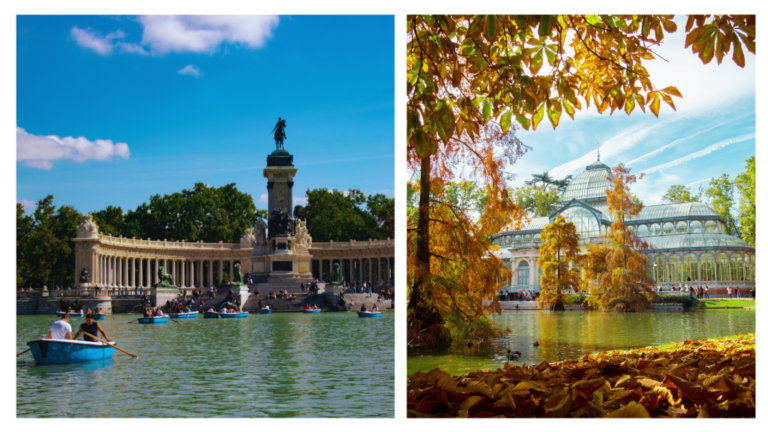
Best seasons to be in Madrid
Madrid is perfect to visit in spring (April to June) and autumn (September to November). Temperatures range between 15 and 25 degrees Celsius, ideal for enjoying the terraces and outdoor events.
In summer, temperatures can exceed 35 degrees Celsius, so it’s recommended to wear light clothing and protect yourself from the sun. In winter, evenings can be chilly, so a light coat is essential.
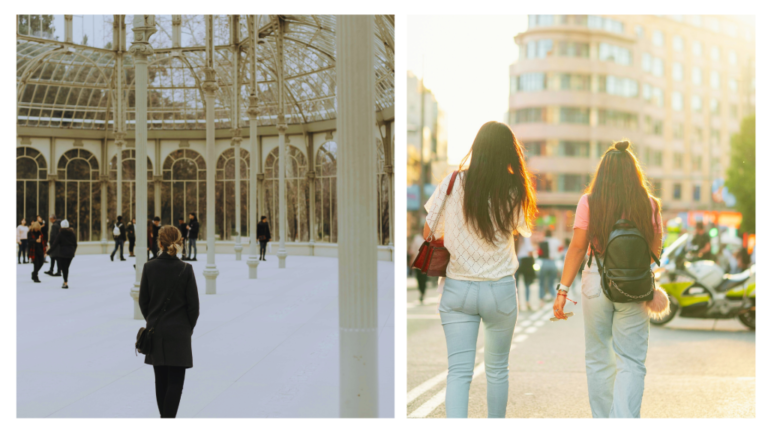
Cost of living as a digital nomad in Madrid
To conclude, we can say that the total cost of living as a digital nomad in Madrid can range between $1,500 and $2,500 per month, depending on your preferences and lifestyle.
With all this information, you’re ready to start your new life as a digital nomad in Madrid, a destination that combines work, culture and remote lifestyle. Welcome to the digital nomad community in Madrid!
| Item | Monthly cost in dollars |
| Accommodation | 700 – 1,300 |
| Co-working spaces | 400 |
| Food | 200 – 300 |
| Transport | 54 (monthly subscription) |
| Health insurance | 40 – 50 |
| Entertainment | 100 – 200 |
| Approximate monthly total | 1,500 – 2,500 |
Frequently Asked Questions about being a digital nomad in Madrid
Yes, Madrid has a wide variety of co-working spaces that encourage collaboration and networking.
Since 2023, Spain offers a specific visa for digital nomads that allows remote workers to reside in the country.
Madrid is more affordable than other European capitals such as London and Paris, which allows for a good quality of life.
Internet quality is excellent, with an average speed of 50 Mbps in most areas, which facilitates remote work.
SafetyWing and World Nomads are good options that offer international coverage tailored to digital nomads.
Although it isn’t essential, knowing some Spanish can facilitate adaptation and everyday life.
Spring (April to June) and autumn (September to November) are ideal for pleasant temperatures and outdoor events.





 Language
Language 


















 No results found
No results found






